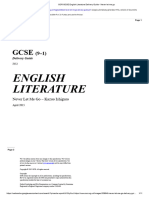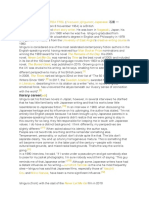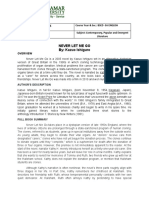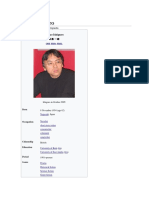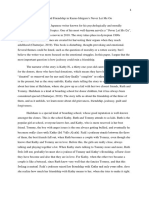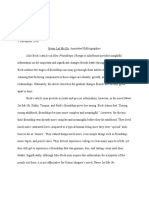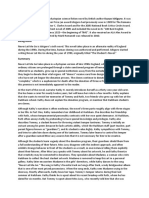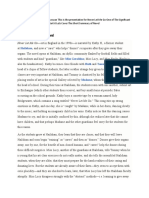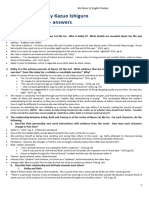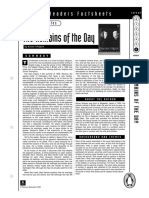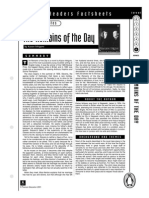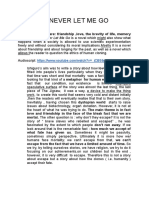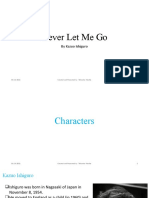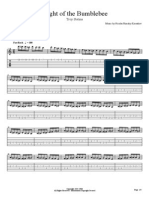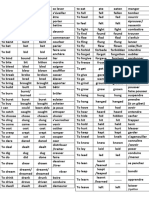Narration in Kazuo-Ishiguro-Never-Let-Me-Go
Uploaded by
Riddhima KapoorNarration in Kazuo-Ishiguro-Never-Let-Me-Go
Uploaded by
Riddhima KapoorlOMoARcPSD|35522550
Kazuo Ishiguro- Never LET ME GO
English Language (Barkatullah University)
Scan to open on Studocu
Studocu is not sponsored or endorsed by any college or university
Downloaded by Riddhima Kapoor (riddhima2433@gmail.com)
lOMoARcPSD|35522550
KAZUO ISHIGURO
Kazuo Ishiguro is the author of seven novels, including Never Let Me Go. Ishiguro was born
in 1954 in Nagasaki, Japan. In 1960, he moved to England with his parents when his father
accepted a research position at the National Institute of Oceanography. The family settled in
the county of Surrey, southeast of London, where Ishiguro attended private schools. Ishiguro
graduated from the University of Kent in 1978 with a degree in English and philosophy. He
began his career as a social worker, but returned to school to pursue a graduate degree in
creative writing at the University of East Anglia. His first novel, A Pale View of Hills (1982),
developed from the drafts that he produced in his creative writing classes. The novel is a
psychologically complex portrait of a middle-aged Japanese widow, living in England and
recalling her experiences years earlier as a young woman in post-war Nagasaki. The novel
brought Ishiguro a first wave of critical acclaim. It also established his interest in writing
first-person narratives, told from the perspective of protagonists who are grappling with their
memories of the past.
Ishiguro continued to explore the theme of post-war memory in his second and third novels,
both of which offer deeply psychological portraits of their narrators. His second novel, An
Artist of the Floating World (1986), returns to the setting of post-war Nagasaki. The narrator
is an aged Japanese painter who grapples with his role as a producer of military propaganda
during World War II. The novel was shortlisted for the prestigious Man Booker Prize.
Ishiguro’s third novel, The Remains of the Day, also takes place in the aftermath of World
War II. The novel follows the reflections of an elderly British butler, as he looks back on his
life in service. Published in 1989, The Remains of the Day won the Man Booker Prize that
same year.
Ishiguro’s psychologically complex works draw on the tradition of the realist novel. He
counts such authors as Charlotte Brontë, Anton Chekov, Charles Dickens, and Fyodor
Dostoevsky among his literary influences. Ishiguro identifies as an international writer. He
does not see his work as part of a Japanese literary tradition, and has stated that he is more
influenced by Japanese films than literature. Although raised in a Japanese-speaking home,
Ishiguro did not return to Japan until he was an adult, visiting briefly in 1989 as part of the
Japan Foundation Short-Term Visitors Program.
The narrators in all of Ishiguro’s novels are characteristically unreliable, often omitting key
details and restraining their emotions. His fourth and fifth novels, The Unconsoled (1995)
and When We Were Orphans (2000), also feature complex narrators dealing with the weight
of the past as a classical pianist and a detective, respectively. Yet these novels depart
stylistically from his earlier works. Ishiguro experimented with a more surreal style in The
Unconsoled, moving away from the realism of his early novels. The Unconsoled was also
shortlisted for the Man Booker Prize. When We Were Orphans meanwhile, takes up the
genres of the psychological thriller and the detective novel.
Downloaded by Riddhima Kapoor (riddhima2433@gmail.com)
lOMoARcPSD|35522550
Context
Never Let Me Go is Ishiguro’s sixth novel. Blending psychological realism with science
fiction, it takes place in a parallel universe in 1990s England where human cloning is an
accepted practice. His first-person narrator is Kathy H., a clone engaged in recalling and
reflecting on her memories of the past. Ishiguro began writing Never Let Me Go in 1990
when he referred to it as “The Students’ Novel.” His early notes featured a group of strange
students living in the countryside, an image that remained core to the finished novel. He
developed the premise of human cloning later in the writing process. Ishiguro initially
abandoned the idea, returning to it briefly after writing The Unconsoled. He picked it up in
earnest after When We Were Orphans and published Never Let Me Go in 2005. The novel
was met with widespread acclaim and was shortlisted that year for the Man Booker Prize as
well as the National Book Critics Circle Award. It was also shortlisted in 2006 for the Arthur
C. Clarke Award, given each year to the best science fiction novel published in the United
Kingdom. A film adaptation directed by Mark Romanek followed in 2010. Ishiguro’s most
recent novel, The Buried Giant, was published in 2015. A quest narrative set in a mythic sixth
or seventh century England, The Buried Giant blends the genres of fantasy and historical
fiction. Ishiguro is also the author of several screenplays and short stories. He lives in London
with his wife and daughter.
Character List
Kathy
The protagonist and the narrator of the novel. Kathy H. is a thirty-one-year-old carer who
wants to make sense of her memories before becoming a donor at the end of the year. Her
recollections express her nostalgic longing for the past, as well as her fierce desire to hold
onto the memory of her childhood friends Ruth and Tommy. Kathy tends to restrain her
emotions, often expressing her feelings only indirectly. She frequently assumes the role of
quiet observer, contrasting with Ruth’s more fiery personality. Kathy is also an unreliable
narrator, and her memories are marked by omissions as well as subjective opinions.
Ruth
Kathy’s childhood friend and a fellow student at Hailsham. Ruth grows up with Kathy at
Hailsham, where Ruth’s charismatic and temperamental personality makes her the natural
leader in their friend group. Ruth is eager to stand out from her peers, and often pretends to
have special knowledge and privileges that other students do not. Ruth is a foil to the more
reserved Kathy, with whom she frequently quarrels. Ruth’s relationship with Tommy
contributes to this tension, as Kathy quietly harbors her own romantic feelings for Tommy.
Although manipulative and cruel at times, Ruth also has moments of genuine thoughtfulness
and caring towards her friends.
Downloaded by Riddhima Kapoor (riddhima2433@gmail.com)
lOMoARcPSD|35522550
Tommy
Kathy’s childhood friend, also a student at Hailsham. As a child, Tommy struggles with
“being creative” and is teased for his lack of artistic abilities. He develops a violent temper,
which he later learns to control. Tommy desires to understand the mysterious aspects of life at
Hailsham. Committed to finding out the truth, he bonds with Kathy through theorizing about
why the school places so much importance on creativity. Tommy has a frank and
straightforward attitude, which contrasts with Kathy’s emotional restraint.
Miss Lucy
One of the guardians at Hailsham. Miss Lucy has a brisk but sympathetic attitude, and works
mostly with the older students. She is conflicted about her role at Hailsham, where she
believes that the guardians are not explicit enough with the students about their futures. Her
frustration often results in odd behavior, including visible flashes of anger.
Miss Emily
The head guardian at Hailsham. Miss Emily is older than the other guardians, and the
students generally find her intimidating. However, they respect her decisions and her
presence at Hailsham makes them feel safe. Miss Emily has a stern demeanor and a sharp
intellect, although she lapses at times into a dream-like daze. When Tommy and Kathy
encounter her again as adults, Miss Emily is self-satisfied and complacent about her failed
charitable work on behalf of the students.
Miss Geraldine
A kind and sympathetic guardian at Hailsham. Miss Geraldine works primarily with the
younger students. The students adore her, and Ruth in particular wants her favor. Miss
Geraldine teaches art classes, and inadvertently encourages the other students to tease
Tommy when she praises his childish watercolor.
Madame (Marie-Claude)
A Hailsham benefactor. Madame occasionally visits Hailsham to take away the best student
artwork, which she is rumored to place in a personal gallery. Her attitude to the students is
distant and cold, leading them to believe that she is afraid of them.
Chrissie
A veteran student who lives at the Cottages, and Rodney’s girlfriend. Chrissie did not attend
Hailsham, and seems to be in awe of the Hailsham students. She is kind and welcoming when
they arrive, but Kathy correctly suspects that that she has a hidden motive. Chrissie hopefully
clings to the possibility of a deferral on donations, rumored to be available to Hailsham
couples in love. She forms a natural alliance with Ruth, who also bases her hopefulness about
the future on rumor and speculation. Chrissie later “completes” on her second donation.
Rodney
Another veteran who lives at the Cottages, and Chrissie’s boyfriend. Friendly and easy-going,
Rodney wears his hair in a long ponytail and likes to talk about reincarnation. Although
Downloaded by Riddhima Kapoor (riddhima2433@gmail.com)
lOMoARcPSD|35522550
Kathy finds Rodney likeable, she also senses that he is generally under Chrissie’s influence.
Rodney did not attend Hailsham. Together with Chrissie, he turns to the Hailsham students
for help in pursuing a “deferral” on their donations.
Laura
A Hailsham student who later moves to the Cottages with Kathy. Laura is an energetic and
mischievous girl at Hailsham, where she is part of Kathy and Ruth’s friend group. But when
she later reconnects with Kathy as a carer, Laura is exhausted and worn down. Laura
encourages Kathy to become Ruth’s carer.
Hannah
Another Hailsham student who moves to the Cottages with Kathy.
Alice
Another Hailsham student who moves to the Cottages with Kathy.
Harry C
A Hailsham student with whom Kathy briefly considers having sex as a teenager.
Keffers
The gruff caretaker at the Cottages.
Ruth’s Possible
An unnamed woman who works at an open-plan office in Norfolk. Kathy and her friends
initially believe that she resembles Ruth, suggesting that the woman might be Ruth’s
“possible,” or the person from whose DNA Ruth was cloned.
Martin
A carer who lives in Norfolk. Martin used to live at the Cottages, and is friends with Rodney
and Chrissie. Although he never appears in the novel, Rodney and Chrissie take Ruth to visit
him after their failed search for Ruth’s possible.
Plot Overview
Never Let Me Go takes place in a dystopian version of late 1990s England, where the lives of
ordinary citizens are prolonged through a state-sanctioned program of human cloning. The
clones, referred to as students, grow up in special institutions away from the outside world.
As young adults, they begin to donate their vital organs. All “donors” receive care from
designated “carers,” clones who have not yet begun the donation process. The clones
continue to donate organs until they “complete,” which is a euphemism for death after the
donation of three or four organs. However, this premise is not immediately apparent to the
Downloaded by Riddhima Kapoor (riddhima2433@gmail.com)
lOMoARcPSD|35522550
reader. At the start of the novel, narrator Kathy H. merely introduces herself as a
thirty-one-year-old carer. She has been a carer for nearly twelve years but will leave her role
in a few months. Kathy explains that she wants to revisit her memories of Tommy and Ruth,
two friends who grew up with her at the Hailsham school. Kathy does not explain the
donation program or mention that Hailsham students are clones.
Although Kathy’s narration is often nonlinear, the novel’s three parts roughly align with the
three stages in her life. In Part One, Kathy remembers her childhood at Hailsham. She
describes her friendship with Ruth, whose temperamental personality contrasts with her own
quiet demeanour. At Hailsham, Ruth often annoys Kathy by pretending to have special
knowledge and privileges. Kathy also describes Tommy, a student known for throwing
violent temper tantrums. Tommy is initially an outcast among his peers because he lacks the
artistic ability, which the Hailsham staff (part teacher, part parent figures known as
“guardians”), and its students value highly. Kathy sympathizes with Tommy, and tries to calm
him down during one of his tantrums. Tommy later learns to control his temper after a
guardian named Miss Lucy assures him that it is not necessary for him to be creative.
Although the students learn vaguely about the donation program, their guardians shield them
from a full understanding of their future. Miss Lucy disagrees with this indirect approach, and
often exhibits strange behaviour in front of the students as a result, in one instance telling
them explicitly about their futures. After Miss Lucy speaks with Tommy about his artwork,
he and Kathy theorize that creativity may be connected to donations. They speculate about
Madame, a woman who visits Hailsham to collect the best student artwork. Madame is
rumoured to keep this art in a personal gallery. Kathy later encounters Madame in the girls’
dormitory, while Kathy dances to the song “Never Let Me Go.” The song is Kathy’s favourite
track on Songs After Dark, a Judy Bridgewater album that is one of her most prized
possessions. When the song ends, Kathy sees Madame crying in the doorway. Shortly
afterwards, Kathy loses her tape. Tommy’s temper returns during their last summer at
Hailsham. Kathy thinks he is upset about his recent breakup with Ruth, whom he has dated
for six months. But Tommy is upset about Miss Lucy, who recently told him that she was
wrong to dismiss the importance of creativity. Miss Lucy departs Hailsham abruptly, and
Tommy mends his relationship with Ruth.
In Part Two, Kathy moves with Ruth and Tommy to a transitional housing facility known as
the Cottages. They adjust to their new lives, becoming acquainted with the “veteran” students
living there already. Ruth often ignores Tommy and Kathy in her efforts to blend in with the
veterans, who are not from Hailsham. Kathy notices that the veterans regard the Hailsham
students with awe. One couple, Chrissie and Rodney, are especially interested in Hailsham.
They convince Ruth to go with them to Norfolk, where Rodney claims to have seen Ruth’s
“possible” in an open-plan office (a “possible” is a human that resembles a specific clone and
from whom that clone's DNA may have been copied). Kathy is skeptical of Rodney’s story,
especially since it features Ruth’s “dream future” of working in an open-plan office. In the
end, Kathy, Tommy, Ruth, Rodney, and Chrissie all drive to Norfolk.
Downloaded by Riddhima Kapoor (riddhima2433@gmail.com)
lOMoARcPSD|35522550
In Norfolk, Chrissie and Rodney ask about a rumored exception allowing Hailsham couples
in love to defer their donations. Ruth pretends to know something about deferrals, which
surprises Kathy and Tommy. The students eventually find the open-plan office. Rodney
points to a woman in the window, and they all agree that she could be Ruth’s legitimate
possible. They follow her to an art gallery, where they realize that the woman does not
actually resemble Ruth. In her disappointment, Ruth says that the students are modeled only
on “trash.” Ruth goes off with Chrissie and Rodney. Meanwhile, Tommy and Kathy find a
copy of Kathy’s lost tape in a secondhand store. Tommy tells Kathy that he has begun
drawing pictures of imaginary animals. He thinks Madame uses the students’ artwork to
determine if couples applying for deferrals are truly in love. After Norfolk, Ruth stops talking
about her dream future. Tommy shows his drawings to Kathy, who finds them puzzling but
captivating. Meanwhile, Kathy’s friendship with Ruth grows increasingly tense. Ruth reveals
that she knows Kathy likes Tommy, but says that Tommy will never return Kathy’s feelings.
Shortly afterwards, Kathy submits her application for carer training and departs.
Part Three focuses on Kathy’s time as carer. While Kathy is good at her job, the work is both
difficult and lonely. She unexpectedly runs into a Hailsham friend named Laura, who is also a
carer. They talk about Ruth, who had a bad first donation. They also talk about Hailsham,
which has closed. Kathy becomes Ruth’s carer, but their relationship is strained and guarded.
One day, Ruth expresses a desire to visit a beached fishing boat near Tommy’s recovery
center. They pick up Tommy on the way to the boat, which they find bleached and crumbling
in a marsh. The marsh reminds both Tommy and Ruth of Hailsham. They also discuss
Chrissie, who completed on her second donation. On the return trip, Ruth apologizes for
keeping Tommy and Kathy apart. She encourages them to pursue a deferral, revealing that
she has discovered Madame’s home address. In the weeks that follow, Kathy and Ruth
reminisce peacefully about Hailsham and the Cottages. Ruth also encourages Kathy to
become Tommy’s carer.
Ruth completes after her second donation. Tommy gives his third donation, and Kathy
becomes his carer. They spend their days reading and talking at his recovery center.
Eventually, they also begin to have sex. Hoping to pursue a deferral, they go to visit Madame
at the address Ruth provided. Madame invites them inside and listens to their request, after
which Miss Emily appears from the next room. Miss Emily says that deferrals do not exist.
She explains that Hailsham was part of a progressive movement committed to raising clones
more humanely. Madame used to exhibit the students’ artwork to show the outside world that
clones had souls. Although the movement once had many supporters, changing public
opinion eventually forced Hailsham to close. On the drive back to his recovery center,
Tommy asks Kathy to pull over. He walks into the woods and begins screaming. Kathy goes
to Tommy and holds him. Soon after, Tommy gives his fourth donation and completes. Kathy
drives to a field in Norfolk, where she allows herself to imagine Tommy on the horizon. Then
she drives away.
Downloaded by Riddhima Kapoor (riddhima2433@gmail.com)
lOMoARcPSD|35522550
Downloaded by Riddhima Kapoor (riddhima2433@gmail.com)
lOMoARcPSD|35522550
Characters’ In-Depth Analysis
Kathy
Kathy H. is the novel’s protagonist and narrator. She is a thirty-one-year-old carer at the
beginning of the novel, although she is preparing to soon become a donor. Kathy has worked
as a carer for nearly twelve years, much longer than most of the students with whom she grew
up at Hailsham. Although she is still a relatively young adult, she has outlived most of her
childhood friends. Kathy spends her days looking backwards, recalling her memories of the
people that she has lost. Through these memories, the novel traces her complex relationships
with her Hailsham friends Tommy and Ruth. Kathy’s reflections also preserve the memory of
Tommy and Ruth, both of whom have already “completed.”
However, Kathy is also an unreliable narrator. Her account is subjective, presenting events
from only her point of view. She does not recall events in strict chronological order,
frequently interrupting one memory to share a related memory from another period in her
life. She often states that she may be misremembering certain details. At times, she also
admits that Tommy or Ruth recalled a particular event or conversation differently than she
does. These idiosyncrasies reflect the unreliability of memory itself, which is necessarily
incomplete and episodic. At the same time, Kathy is also an unreliable narrator because she
carefully guards her own feelings. Kathy never explicitly states the depths of her feelings for
Tommy, for instance, although her love becomes increasingly clear as the narrative unfolds.
Kathy’s memories likewise show her reliance on silence and indirection, especially when it
comes to expressing her emotions. For instance, Kathy often expresses her anger with Ruth
by walking away rather than explicitly confronting her. As a student at Hailsham, Kathy
exhibits restraint and self-consciousness. She often worries about being seen or overheard,
especially in conversation with Tommy. Kathy also frames herself as a careful observer. She
often stands outside the action in her memories, carefully watching those around her and
noticing subtle details about their behavior. At the Cottages, for instance, Kathy realizes that
many of the veteran couples have copied their gestures of affection from television.
Ruth
Ruth is Kathy’s close childhood friend. Kathy lives with Ruth at Hailsham and at the
Cottages, and later becomes Ruth’s carer when Ruth is a donor. At Hailsham, Ruth is
outspoken and hot-tempered. She is a natural leader among her friends, although she is often
highly controlling as well. Ruth is a foil to Kathy’s quieter and more guarded personality, and
the two argue frequently. But like Kathy, Ruth generally quarrels using subtle hints and
indirection rather than direct confrontation. As a teenager, Ruth also begins a longstanding
Downloaded by Riddhima Kapoor (riddhima2433@gmail.com)
lOMoARcPSD|35522550
romantic relationship with Tommy. This is an underlying and unspoken source of tension in
her friendship with Kathy, who has romantic feelings for Tommy as well.
At Hailsham, Ruth often leads her friends in make-believe games. Her most elaborate
invention is the “secret guard,” dedicated to protecting her favorite guardian Miss Geraldine
from an imaginary plot. The fantasy of the secret guard shows Ruth’s controlling personality,
but it also reflects her larger tendency to “pretend” around her peers. Ruth often implies that
she has special knowledge and privileges unavailable to other students. For instance, Ruth
hints that she receives special favors from Miss Geraldine. This habit annoys Kathy, who
usually suspects that Ruth is lying and quarrels with her over it. However, Ruth’s pretending
also shows her earnest desire to believe in hopeful possibilities. At Hailsham, her hints about
Miss Geraldine reflect her longing for affection from a caring adult. At the Cottages, Ruth
indulges in the fantasy of her “dream future” and pins her hopes on the vague story of her
“possible,” or a person who resembles her and from whose DNA she may have been cloned,
in Norfolk.
Ruth can be capricious and unkind to both Tommy and Kathy. In her attempts to fit in at the
Cottages, she often ignores and mocks both of them. However, Ruth has the capacity for deep
generosity and thoughtfulness as well. When Kathy loses her Judy Bridgewater tape at
Hailsham, for instance, Ruth marshals their classmates to search for it and then gifts her a
different tape as a substitute. Later, Ruth also offers Kathy and Tommy the gift of Madame’s
address, which demonstrates Ruth’s inherent hopefulness because that she believes Kathy and
Tommy still have the chance to ask Madame for a deferral on their donations. Through the
offering of Madame’s address, Ruth shows her sincere desire to make amends for keeping
Kathy and Tommy apart.
Tommy
Tommy is Kathy’s close childhood friend, for whom she also harbors romantic feelings. At
Hailsham, Tommy becomes an outcast among his peers because, unlike them, he lacks artistic
ability. He develops a violent temper, often throwing tantrums in response to teasing from his
peers. Tommy remains anxious and self-conscious about his artistic abilities as a young adult,
initially keeping his artwork a secret at the Cottages. However, he also begins to derive pride
and personal satisfaction from drawing. His compelling imaginary animals resist
interpretation, reflecting the deep humanity and complex individuality of the clones
themselves.
Tommy is in many ways more straightforward than Kathy and Ruth, often missing the subtle
digs and sarcasm that they shoot back and forth. While Kathy often knowingly defends
Ruth’s pretenses in front of others, Tommy usually expresses his confusion or doubt aloud.
He also lacks the kind of emotional restraint that Kathy and Ruth exhibit. While Kathy and
Ruth tend to express their angers and frustrations indirectly, Tommy is prone to violent
temper tantrums. Yet Tommy also has vey different relationships with Ruth and Kathy. He
Downloaded by Riddhima Kapoor (riddhima2433@gmail.com)
lOMoARcPSD|35522550
maintains a longstanding but difficult romantic relationship with Ruth, who at times belittles
and ignores him. Meanwhile, he bonds with Kathy over their mutual desire to discover the
truth about Hailsham. Tommy tends to trust Kathy with his biggest secrets, including his odd
conversations with Miss Lucy. In his theorizing with Kathy, Tommy also shows an observant
and reflective side to his personality that mirrors her own.
THEMES
Identity
When they are at Hailsham, Kathy and her friends are like many young people in that they
are consumed with questions about themselves and their place in the world. However, for
Kathy, Tommy and Ruth, this predicament is made much harder because they also have to
wonder who they are and who they might have been cloned from. Unlike normal humans
they do not know their family history and therefore cannot ever be sure if they have a certain
eye colour because one of their parents has the same eye colour, or if they have inherited a
talent from another family member. Part of their identity therefore will always remain a
mystery to them and this adds to their confusion about who they are and their place in the
world.
Later in the novel the reader sees how a sighting of Ruth’s possible results in the group of
friends taking a trip to Norfolk to see if they too can catch a glimpse of her, “The way I
remember it, sightings of possibles tended to come in batches. Weeks would go by with no
one mentioning the subject, then one reported sighting would trigger off a whole spate of
them,” recalls Kathy.
The possibles are the only link the clones have with their true identity and so Ruth suffers a
huge disappointment when it becomes obvious that she has not been cloned from the woman
Rodney believes is her possible, A bit of fun for you maybe, Tommy,” Ruth said coldly, still
gazing straight ahead of her. “You wouldn’t think so if it was your possible we’d been
looking for.' Here Ruth’s bitterness reveals how all of her hopes were pinned on discovering
the office worker in Norfolk was the woman from whom she had been cloned.
This leads to another conversation about the type of people the students were generally
cloned from and this serves to further increase their confusion regarding their identity. Ruth
claims that they have all been cloned from, trash, as no respectable human would allow
themselves to be cloned.
In Hailsham, Kathy, Ruth, Tommy and their peers were used to being treated as special, those
clones who did not attend Hailsham see it as a privileged school to have attended. Having to
face the reality of the true backgrounds of their possibles is something else which therefore
adds to the characters’ identity crisis.
Downloaded by Riddhima Kapoor (riddhima2433@gmail.com)
lOMoARcPSD|35522550
One of the reasons why the students at Hailsham treasure their collections so much is that
each collection hints at their individuality and therefore their own identity. The wooden
chests in which each student stores the items they have purchased at the Sales or picked up at
the Exchanges are all individual to them and therefore highlight each student’s own particular
preferences and choices. They become a motif of identity.
Similarly, each student is encouraged to develop their own artistic talents and these talents
also help promote their own unique identities. In her narration Kathy recalls Patricia C who
was well known throughout the school for her drawing skills, Patricia was two years below us
but everyone was in awe of her drawing skills, and her stuff was always sought after at the
Art Exchanges. Tommy’s unhappiness at Hailsham could stem partly from his lack of artistic
talent. He is not recognised as being talented and therefore feels he is not recognised as an
individual with a unique identity of his own.
How is the theme of identity shown in the novel?
In Never Let Me Go, Kazuo Ishiguro shows the theme of identity through:
>the students’ keenness to find their possible
>the importance of the Collections in the students’ lives
>the need to have artistic talent as a way of projecting a unique identity
Friendship
The students at Hailsham are like many other students of their age. Friendships are very
important to them. People argue with each other, make up with each other or simply change
their friendship groups. However, what is different for Kathy and her friends at Hailsham is
that apart from the guardians, all they have is each other. Therefore, their friendships become
more important and much more intense.
Ishiguro’s presentation of the friendship groups in Never Let Me Go is very realistic. He
portrays Ruth as a typical leader, the girl many other students look up to, and Tommy as the
student who is often goaded into making a fool of himself for the entertainment of his friends.
Ishiguro also shows that as well as having silly quarrels with each other, But the next second
Ruth gave a little laugh and said: ‘The idiot! (Kathy), the students also care for each other and
offer support when it is needed, 'It’s nothing to worry about,' I said before the silence got
humiliating for him. 'It’ll come off. If you can’t get it off yourself, then just take it to Miss
Jody.' (Kathy to Tommy). In a way, Hailsham is a glue that bonds its students together. Even
when they fall out, they will still be tied together because of their shared history, shared
experiences, and the fact that they know so much about one another.
There are moments during the novel when Ruth hurts Kathy greatly. During their time at The
Cottages, Ruth tries hard to be like one of the veterans and as a result, often snubs Kathy in
the process or humiliates her by pretending to have forgotten an event that Kathy remembers
quite clearly. Ruth’s behaviour is partly to blame for Kathy deciding to leave The Cottages to
Downloaded by Riddhima Kapoor (riddhima2433@gmail.com)
lOMoARcPSD|35522550
begin her career as a carer. However by the end of the novel, Kathy has become Ruth’s carer
and their fondness for each other has returned.
The Relentless Passage of Time and the Inevitability of Loss
“The memories I value most, I don’t see them ever fading. I lost Ruth, then I lost Tommy, but
I won’t lose my memories of them.”
Although she is only thirty-one at the start of the novel, Kathy has almost reached the end of
her life. She has lost almost everyone she knew from Hailsham, holding onto them only in
her memories. While Kathy’s retrospective narration shows the inevitability of loss, many of
her memories reflect a desire to slow the relentless march of time towards these losses. The
deferral rumor clearly reflects this desire: in hoping for deferrals from donating organs, the
students embody the deeply human wish for more time in the face of death. But even the idea
of a deferral reinforces the inevitability of death and loss: a deferral is only a brief extension
on life, a temporary hold that puts off the future instead of changing it. This same desire for
more time ironically motivates the donation program, which depends on the students’ internal
organs to extend the lives of people in the outside world.
The Power of Memory
Kathy copes with the losses in her life by turning to memories of the past. She preserves the
memory of Hailsham long after it has closed, just as she preserves her memories of Tommy
and Ruth long after their deaths. The novel’s title epitomizes this desire to hold on. The
phrase “never let me go” is somewhere between a plea and a demand, reflecting a deeply
human need to hold onto, and be held by, loved ones. Kathy’s memories are her way of
holding onto everyone and everything she has lost. However, Kathy’s memory is also
fragmented and somewhat incomplete. Her narrative is a process of recovery and an attempt
to make sense of her memories. She admits to forgetting and misremembering details,
showing that memory is just as fragile as it is powerful. Her first-person narration also
highlights the absence of other characters’ memories. Ruth and Tommy only appear as
reflected through Kathy’s memory, which means that their own thoughts and motivations
remain somewhat ambiguous.
The Dignity of Human Life
Kathy’s narrative is ultimately a testament to the dignity and humanity of the students whom
she remembers. The students have less time than their counterparts in the outside world, but
their lives are as rich with the hopes, joys, disappointments, and sorrows that define human
experience. Kathy’s memories also ironize the efforts of Miss Emily and Madame to
demonstrate the students’ humanity through their childhood artwork. Despite their good
intentions, both Miss Emily and Madame feel revulsion towards the students whose lives they
seek to improve. Kathy, meanwhile, shares the memories of her loved ones with quiet dignity
and tenderness. Her narrative speaks for itself, showing the depths of her humanity in ways
that Madame and Miss Emily are not capable of doing.
Downloaded by Riddhima Kapoor (riddhima2433@gmail.com)
lOMoARcPSD|35522550
Symbols
Symbols are objects, characters, figures, and colours used to represent abstract ideas or
concepts.
The Open-Plan Office
The open-plan office appears three times in the novel and symbolizes the students’ gradually
diminishing sense of possibility for the future. Ruth and Kathy first see the office in a
magazine, where it inspires what Ruth refers to as her “dream future.” At this point, none of
the students have begun donating organs. They are in a transitional period between childhood
and adulthood, and still able to hold onto the dream of an alternate future. The open-plan
office reappears in Norfolk, where the students search for Ruth’s “possible.” Here, the office
signals the closing off of possibility. The woman in the office turns out to not be Ruth’s
possible, solidifying the impossibility of Ruth’s dream future. The office itself has
floor-to-ceiling glass windows, which emphasize the students’ relation to the “dream future”
that it represents: they can observe it from the outside, but cannot actually participating in it.
The open-plan office reappears on a billboard when Tommy, Ruth, and Kathy are returning
from their visit to the boat in Norfolk. At this point, the office has a far more sobering effect.
It is a reminder of past dreams at a moment when the future for all three has already been set
in motion. Yet the open-plan office also remains a symbol of hope, as Ruth hands Madame’s
address to Kathy and Tommy underneath the billboard. Ruth knows that her life is almost
over, but Madame’s address introduces the possibility that at least Tommy and Kathy might
extend their time together.
The Song “Never Let Me Go”
As a child at Hailsham, Kathy acquires a cassette tape of the Judy Bridgewater album Songs
after Dark at one of the Sales. Her favorite track on the album, “Never Let Me Go,” gives the
novel its title. The song symbolizes both the depths of human love and the fear of losing
those whom one loves. This becomes clear in the story that Kathy invents to explain the
song’s lyrics. Kathy imagines that the song is about a woman afraid of losing her baby.
Holding tightly to the child, she sings a song that expresses her happiness as well as her fear
of loss. This image of holding on recurs several times in the novel, most notably when Kathy
and Tommy hold one another in the field after learning that deferrals do not exist. When the
tape itself disappears, Kathy has her first experience of loss that presages the losses she will
later experience on a much larger and more human scale.
The crumbling boat is a symbol of mortality, highlighting the passage of time and the
inevitability of loss that comes with it. Kathy’s visit to the boat with Ruth and Tommy echoes
their first trip to Norfolk, but with noticeable differences. Both Chrissie and Rodney are
absent, and their conversation reveals that Chrissie has already completed. Ruth and Tommy
are both donors at this point, and Ruth exhibits signs of physical weakness. The boat itself
Downloaded by Riddhima Kapoor (riddhima2433@gmail.com)
lOMoARcPSD|35522550
recalls a bleached skeleton, and is noticeably surrounded by dead tree trunks. The scene
before them reminds both Tommy and Ruth of Hailsham, but a Hailsham transformed with
the passage of time. Tommy speculates that Hailsham looks like the marsh now that it has
closed, while Ruth shares her dream of a Hailsham surrounded by floodwaters. Although
their visit is tinged with sadness and a sense of loss, the students also find the boat beautiful.
In this way, the boat echoes their memories of Hailsham. They cannot revisit Hailsham or
their childhood there together. The ghostly boat in the marsh is as close to recovering this
past as they can come.
Motifs
Motifs are recurring structures, contrasts, and literary devices that can help to develop and
inform the text’s major themes.
Copies
The motif of copies and copying begins with the students themselves, who are clones copied
from models in the outside world. Kathy later notices that the students at the Cottages copy
their gestures and mannerisms from what they watch on television, and sees Ruth copy her
idea of a perfect future from a magazine ad. These observations confirm for Kathy that the
students are living in imitation of the real world. Copies reappear in Norfolk, where Kathy
finds a copy of her lost tape after a disappointing search for Ruth’s “possible.” Yet although
the students are copies, the novel ultimately speaks to their originality and individuality. For
instance, Tommy’s imaginary animals are a counterpoint to the gestures of copying that
Kathy observes at the Cottages. His drawings are intricate and surprising creations, difficult
to interpret and highly compelling. In this way, Tommy’s drawings parallel the novel itself:
Kathy’s narrative is not a copy, but a complex and compelling account that is deeply personal
to her experience.
Pretending and Fantasy
This motif recurs throughout the novel, where most of the characters participate in some form
of pretending or fantasy. Hailsham itself is an elaborate act of pretending, signaled by the
“sham” embedded in its name. In order to shield students from their future, for instance, the
Hailsham guardians refuse to speak directly about donations. Ruth’s childhood make-believe
games at Hailsham are another form of pretending, a fantasy in which she has control of
secret information that others do not. However, even fantasies at Hailsham reflect a shadow
of reality: the imagined plot against Miss Geraldine reflects the students’ real fears about
what lies beyond the walls of Hailsham, as well as their fears of losing the guardians who
protect them. As they grow older, the students engage in various fantasies about the future,
such as Ruth’s dream of working in an office and the rumored deferrals on donations. These
fantasies become increasingly limited as time goes on, until Kathy is left alone with just the
fantasy of Tommy on the horizon.
Downloaded by Riddhima Kapoor (riddhima2433@gmail.com)
lOMoARcPSD|35522550
Lost and Found
This recurring motif begins with Miss Emily’s description of Norfolk as a “lost corner,”
which causes the students to imagine that all lost property found in England winds up in
Norfolk. The idea of finding lost objects in Norfolk is a childhood comfort to the students at
Hailsham. It reassuringly suggests that if loss is inevitable, what is lost can always be found
again. However, this fantasy becomes less compelling to the students as they grow older and
begin to experience human loss. Although Kathy finds a copy of her lost cassette tape in
Norfolk, it only awakens a wish to believe in Norfolk’s power. When Kathy returns to
Norfolk after Tommy’s death at the end of the novel, she does so only to indulge one last time
in the fantasy of recovering what she has lost. Ultimately, Kathy can recover her losses only
in her memory and in her imagination.
FORM, STRUCTURE AND LANGUAGE IN NEVER LET ME GO
Use of form in Never Let Me Go
Kazuo Ishiguro chose to write Never Let Me Go in the form of a novel. It was published in
1995 and was later nominated for the Booker Prize. It was a critically successful novel and
was made into a film for which Ishiguro wrote the screenplay.
When analysing form in Never Let Me Go you can refer to:
the type of text it is
the style of writing
Evidence and explanation of the form used
Writing Never Let Me Go as a novel gave Kazuo Ishiguro the opportunity to develop his
investigation into the important themes that he wished to discuss, such as identity and
nostalgia. It also allowed him to look at the moral implications of human cloning and the way
society treated the student clones. This meant that Ishiguro could also take his time over the
presentation of characters such as Ruth and Tommy, who are quite complex characters.
The narrative voice used in the novel
Never Let Me Go is written in the first person and the story is told entirely from Kathy’s
point of view. My name is Kathy H. I’m 31 years old. The action and characters are presented
entirely as Kathy herself perceives them, And I realised that for Ruth and the others,
whatever the boys chose to do was pretty remote from us... The reader therefore only finds
out about events if Kathy herself remembers them and is only allowed to view the events
from Kathy’s point of view. Kathy only informs the reader about the events she wants them to
know about, so certain key occurrences may be kept hidden, therefore distorting the reader’s
knowledge and understanding.
Downloaded by Riddhima Kapoor (riddhima2433@gmail.com)
lOMoARcPSD|35522550
This requires the reader to do a certain amount of perceptive thinking of their own. For
example, the reader needs to consider if Kathy can be trusted as a narrator. They need to ask
themselves if she narrates events as they really happened or if she retells events in such a way
that forces the reader to see them how she wants them to be seen. What reasons would she
have for not telling the truth about certain events? This is an important question to ask when
considering Kathy’s role as the narrator.
It is also important to look closely at the opening page of the novel. Kathy assumes the reader
has a certain amount of prior knowledge about life in the society in which she lives, but of
course they do not. This makes the opening quite confusing until certain details become
apparent as the novel progresses. For example, the reader is unclear why Kathy does not
provide her full surname, what the role of a carer actually entails, I’ve been a carer now for
over eleven years, and what being a donor is all about, My donors have always tended to do
much better than expected. The reader is also unaware what Kathy means when she says, I’m
a Hailsham student – which is enough by itself to get people’s backs up. Kathy’s narration is
intriguing, it provides questions but very few answers and therefore the reader is drawn into
her narrative in their determination to find out more.
Use of Structure in NLMG
At the opening of the novel Kathy tells us that she is 31 years old but most of her narration
involves her memories of the past, when she was a student at Hailsham School or when she
was living at The Cottages. Therefore, her narration is not straightforward or chronological,
as she tends to jump from recalling one incident to another in a very non-linear way.
Often, Kathy begins to recall a certain incident but will get easily tempted into reminiscing
about another event, or giving the reader information about other students or guardians.
During Chapter Four Kathy begins to tell the reader about the head guardian, Miss Emily.
However, she interrupts her recollections with, But that’s not really what I want to talk to you
about just now. What I want to do now is get a few things down about Ruth, about how we
met and became friends, about our early days together. Kathy has total control over her
narrative and the reader has to wait for Kathy to decide when she wants to give further
information about Miss Emily before they find out more about the head guardian.
Part One of the novel mainly involves Kathy’s memories of Hailsham, Our day at Hailsham
always began with an assembly, which was usually pretty brief, although as nothing is
straightforward in Kathy’s narration she also mentions her role as a carer, I won’t be a carer
any more come the end of the year, and though I’ve got a lot out of it, I have to admit I’ll
welcome the chance to rest - to stop and think and remember. At this point the reader is not
clear what her rest actually entails and certainly does not realise it involves donation and
completion, which in this context means death. Kathy’s recollections of Hailsham are detailed
and she provides the reader with intricate memories about her daily life at Hailsham, the other
students, the guardians and the buildings that were part of the school, The pavilion was big
enough to take two separate groups without them bothering each other.
Downloaded by Riddhima Kapoor (riddhima2433@gmail.com)
lOMoARcPSD|35522550
During Part Two of the novel, Kathy’s narrative is mainly about her time at The Cottages and
other characters are introduced such as the veterans, Chrissie and Rodney. However, the
shadow of Hailsham looms large and it is not long before Kathy begins introducing memories
of her life at school into her narrative, I think about the essay the same way I might a
rounders match at Hailsham I did particularly well in... Her past life at Hailsham consumes
her and the structure of the novel reflects this. Kathy never properly moves on from
Hailsham, it remains an important part of her life long after she has actually left the school.
During Part Three of Never Let Me Go Kathy has left The Cottages in order to become a
carer. Although she meets many donors, she still finds it hard to forget Hailsham and her old
friends from the school. Eventually she gives in, realising that Ruth and Tommy are the only
people she has ever really cared for, There have been times over the years when I’ve tried to
leave Hailsham behind, when I’ve told myself I shouldn’t look back so much. But then there
came a point when I just stopped resisting. This results in Kathy becoming Ruth’s carer and
beginning a relationship with Tommy. When both her friends complete, Kathy is left alone so
that the ending of the novel is rather like the beginning, with Kathy contemplating her future
as a donor and for a time at least continuing with her role as a carer, I just waited a bit, then
turned back to the car, to drive off to where I was supposed to be.
How to analyse structure
How important is the overall structure of this novel?
The structure of this novel is important because it allows the reader to see that Kathy never
moves on from her time at Hailsham School. Although she physically leaves the school
behind and moves first to The Cottages and then becomes a carer, Kathy remains emotionally
tied to Hailsham.
Throughout her entire narrative, Kathy’s memories of Hailsham School impact upon her
present life so that she is unable to live in the present without recalling her past, It was that
exchange, when we finally mentioned the closing of Hailsham, that suddenly brought us
close again, and we hugged, quite spontaneously, not as much to comfort one another, but as
a way of affirming Hailsham, the fact that it was still there in our memories. Here, the reader
can see that Kathy is not the only student to recall Hailsham with fondness. When Laura,
another ex-student, also recalls Hailsham, it helps her to reconnect with her past and she takes
comfort from this, particularly as she finds her role as a carer a difficult one.
Use of language in NLMG
The language Kazuo Ishiguro uses in his novel is realistic and reflects the time in which the
novel is set (the 1990s). Kathy and her friends speak very much as you would expect young
people to speak, although at the same time it is impossible to deny that there is something
rather middle class about the language they use and the context of their discussions, I’d
assumed Ruth was something of a chess expert and that she’d be able to teach me the game.
After all, Hailsham is perceived as being a rather prestigious school to attend and until the
reader knows differently, it could almost be seen as a private boarding school.
Downloaded by Riddhima Kapoor (riddhima2433@gmail.com)
lOMoARcPSD|35522550
Kathy is a chatty and open narrator and her engaging style makes it easy for the reader to
become absorbed in the novel. She does not clutter her narrative with difficult words,
although she does make several literary references to novels she is reading and these help to
reflect the realism of her education at Hailsham, "I was lying on a piece of old tarpaulin
reading, as I say, Daniel Deronda..."
One of the key aspects of Kathy’s narration is that it uses the language of acceptance. Neither
Kathy nor the other clones ever use words which reflect the fact that they might be tempted to
rebel against their future roles as donors. They simply accept the fact that before they are
middle aged they will have completed and that their lives will be over. Their language
choices are not those of rebels who are planning a revolution but rather the language choices
made by a class of people who have quietly accepted their future fate.
When analysing the language Kazuo Ishiguro has used, aim to:
Examine words and phrases.
Think about the sort of words he chose (positive, negative, descriptive, accepting).
Explore layers of meaning (What else could a phrase refer to or suggest?).
Notice any literary techniques, (similes, metaphors, alliteration).
Explain the effects of the language used – how does it make you feel?
Evidence and explanation of the language used
Colloquial language that would be used by young people at the time
How?
Kathy and her friends use a mixture of formal and informal language and can pick the right
occasion to make the right language choices, Don’t talk rubbish Tommy. (Kathy to Tommy)
Why?
Kazuo Ishiguro is making his novel as realistic as possible. Therefore the students know that
they must speak in a more formal way when speaking to a guardian but when speaking to
their friends, they are informal and relaxed.
Effect
This allows the reader to see that the clones are exactly the same as humans of the same age.
The student clones behave and react in similar ways. Therefore, when society finds it
acceptable to use the clones in order to donate their vital organs, the reader can see for
themselves what a truly dystopian society this is.
Key Facts to Remember
Full Title- Never Let Me Go
Author - Kazuo Ishiguro
Downloaded by Riddhima Kapoor (riddhima2433@gmail.com)
lOMoARcPSD|35522550
Type Of Work - Novel
Genre - dystopia; science fiction; coming-of-age story
Language - English
Time And Place Written - England, between 1990 and the early 2000s
Date Of First Publication - 2005
Publisher - Knopf (New York), Faber and Faber (London)
Narrator - Kathy H.
Point Of View- The narrator (Kathy) speaks in the first person, so the reader only sees her
point of view. Kathy describes her memories of characters and events subjectively, offering
her own thoughts and reflections. She frequently makes assumptions about the thoughts and
motivations of others.
Tone - Reflective, nostalgic, somber
Tense - Kathy speaks in the present tense, but switches to past tense when sharing memories
of the past.
Setting (Time)- Late 1990s, although Kathy’s memories reach as far back as the early 1970s.
Setting (Place) - Various locations in England, including the (fictional) Hailsham school, the
(also fictional) Cottages, and the towns of Norfolk, Dover, and Kingsfield.
Protagonist- Kathy H.
Major Conflict Kathy wrestles with the loss of her childhood friends Ruth and Tommy by
turning to her memories the past, recalling her complex relationship with each one and with
the Hailsham school where they grew up together.
Rising Action - Kathy recalls growing up with Ruth and Tommy at Hailsham, where
ambiguous references to their future as “donors” punctuate their idyllic childhood. As they
become young adults, they hope in different ways for the possibility of changing or deferring
this future.
Climax- Kathy and Tommy visit Madame’s house, where Miss Emily cuts off their last hope
for more time together when she reveals that deferrals on donations do not exist.
Downloaded by Riddhima Kapoor (riddhima2433@gmail.com)
lOMoARcPSD|35522550
Falling Action- Kathy spends a last few weeks with Tommy before he completes on his
fourth donation, leaving her with her memories as she waits to become a donor herself.
Themes - The relentless passage of time and the inevitability of loss; the power of memory;
the dignity of human life
Motifs - Copies, pretending and fantasy, lost and found
Symbols - The open-plan office, the song “Never Let Me Go,” the boat
Foreshadowing - The woods beyond Hailsham foreshadow the grim future awaiting the
students when they leave; Tommy’s childhood tantrums foreshadow the grief that he and
Kathy share in the aftermath of their visit to Madame; the loss of Kathy’s tape foreshadows
the many losses that she will later experience as an adult
Downloaded by Riddhima Kapoor (riddhima2433@gmail.com)
You might also like
- English Literature Never Let Me Go - Kazuo IshiguroNo ratings yetEnglish Literature Never Let Me Go - Kazuo Ishiguro18 pages
- Introspecting Social Alienation in The Characters of Kazuo Ishiguro-1No ratings yetIntrospecting Social Alienation in The Characters of Kazuo Ishiguro-13 pages
- Teo, Yugin - Testimony and The Affirmation of Memory in Kazuo Ishiguro's Never Let Me Go100% (1)Teo, Yugin - Testimony and The Affirmation of Memory in Kazuo Ishiguro's Never Let Me Go12 pages
- Joslyn Fox File 04 Never Let Me Go Assgt AnswersNo ratings yetJoslyn Fox File 04 Never Let Me Go Assgt Answers3 pages
- Jelousy and Friendship in Kazuo Ishiguro's Never Let Me GoNo ratings yetJelousy and Friendship in Kazuo Ishiguro's Never Let Me Go4 pages
- Kazuo Ishiguro: Writing Journey & InsightsNo ratings yetKazuo Ishiguro: Writing Journey & Insights25 pages
- Annotated Bibliographies on Never Let Me GoNo ratings yetAnnotated Bibliographies on Never Let Me Go6 pages
- Identity in 'Never Let Me Go' - Jeff PedleyNo ratings yetIdentity in 'Never Let Me Go' - Jeff Pedley36 pages
- The Remains of The Day: Penguin Readers FactsheetsNo ratings yetThe Remains of The Day: Penguin Readers Factsheets4 pages
- The Remains of The Day: Penguin Readers FactsheetsNo ratings yetThe Remains of The Day: Penguin Readers Factsheets4 pages
- Neverletme Go:: Memories in Kazuo Ishiguro'S A Clone'S HumanityNo ratings yetNeverletme Go:: Memories in Kazuo Ishiguro'S A Clone'S Humanity17 pages
- Faber Firsts A Pale View of Hills by Kazuo IshiguroNo ratings yetFaber Firsts A Pale View of Hills by Kazuo Ishiguro5 pages
- 14 - Literature Study - (2) Never Let Me Go' Part 1 - Chapter 2No ratings yet14 - Literature Study - (2) Never Let Me Go' Part 1 - Chapter 216 pages
- An Artist of The Floating World LitChartNo ratings yetAn Artist of The Floating World LitChart58 pages
- Summary and Critical Analysis of "What Is Swaraj?" - by M.K. Gandhi100% (1)Summary and Critical Analysis of "What Is Swaraj?" - by M.K. Gandhi23 pages
- UGC NET PAPER 1 QUESTIONS & ANSWERS From July 2018 To Dec 2023No ratings yetUGC NET PAPER 1 QUESTIONS & ANSWERS From July 2018 To Dec 2023230 pages
- Holy Child of Mary College Sto. Niño, Masantol Pampanga 6 Monthly Exam in English 10No ratings yetHoly Child of Mary College Sto. Niño, Masantol Pampanga 6 Monthly Exam in English 104 pages
- The Golden Age of Jewish American Literature: Discovery Guides100% (1)The Golden Age of Jewish American Literature: Discovery Guides13 pages
- MARLENE DUMAS - Contemporary Portraiture's Split ReferenceNo ratings yetMARLENE DUMAS - Contemporary Portraiture's Split Reference6 pages
- Cassandra's Dream Song - An In-Depth Analysis Using A Modified Schenkerian ApproachNo ratings yetCassandra's Dream Song - An In-Depth Analysis Using A Modified Schenkerian Approach22 pages
- Adrian Sheppard in Conversation With Antonella MarziNo ratings yetAdrian Sheppard in Conversation With Antonella Marzi20 pages
- 2025 Grade 12 Tourism Icons Questions Previous QP100% (7)2025 Grade 12 Tourism Icons Questions Previous QP7 pages








